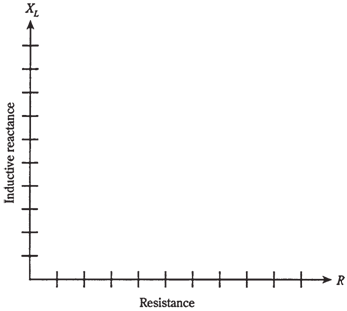Points in the RL plane:
Inductive reactance can be plotted along the half line, just as a resistance. In the circuit containing both the resistance and inductance, characteristics become 2 dimensional. You can orient resistance and reactance half lines perpendicular to each other to make the quarter plane coordinate system, as shown in the Figure given below. Resistance is plotted horizontally, and inductive reactance is plotted vertically.
In this pattern, RL combinations form impedances. Each point on RL plane corresponds to 1 unique impedance value. On the other hand, each RL impedance value corresponds to 1 unique point on the plane.
The impedances on the RL plane are written in form R = jXL, here R is the resistance and XL is inductive reactance.
If you have the pure resistance, say R= 5 Ω, then complex impedance is 5=j0, and is at the point (5,0) on RL plane. If you have the pure inductive reactance, such as

Figure-- The RL quarter-plane.
XL = 3 Ω, then complex impedance is 0 + j3, and is at point (0, 3) on RL plane. These points, and others, are shown in the Figure given above.
All the coils have some resistance, as no wire is a perfect conductor. All the resistors have at least small of inductive reactance, as they take up some physical space. So there is no such thing as a mathematically perfect pure resistance like 5 + j0, or a perfect pure reactance such as 0 + j3. At times you can get pretty close, but pure resistances or reactances do not exist, if you want to get really theoretical.
Often, resistance and inductive reactance are deliberately placed in the circuit. Then you get impedances values such as 2 + j3 or 4 + jl.5. These are shown in Figure given below as points on the RL plane.
Remember that the values for XL are reactances, not the actual inductances. Thus, they vary with the frequency in RL circuit. Changing frequency has the effect of making the points move in RL plane. They move vertically, moving upwards as the alternating current frequency increases, and downwards as alternating current frequency decreases. If the alternating current frequency goes down to zero, the inductive reactance disappears. Then XL =0, and the point is along resistance axis of RL plane.